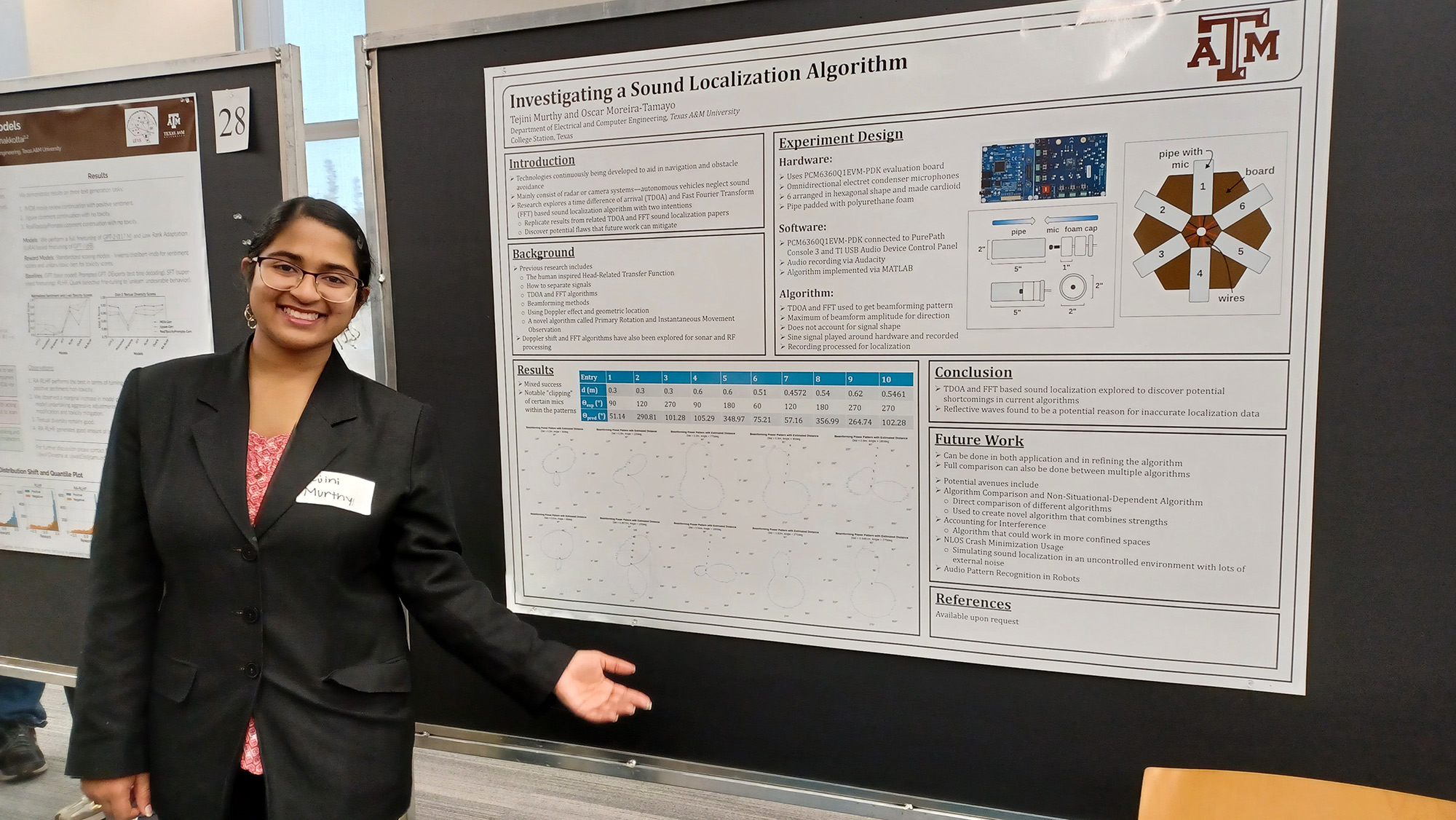
At the age of 13, most teens find themselves settling into their final year of middle school, trying to balance homework, recess and gym. Tejini Murthy ’24, however, was facing a much bigger challenge — finding the right university to begin her undergraduate studies in computer engineering.
"My high school journey started when I was 9 years old," Murthy says. "My parents helped me build a transcript so I could complete all my needed credits for a diploma. They encouraged a well-rounded and complete education, which I’m very grateful for."
While navigating high school at such a young age came with its own set of challenges, a much larger question loomed for the child prodigy — where would Murthy go next?
"My family and I knew I was going to finish high school at 13 but weren’t sure what to do next," says Murthy. "I wanted to start college, but my parents were worried about sending me to a university so early."
Nevertheless, Murthy's unwavering pursuit eventually led her to the Texas A&M University Engineering Academy at Austin Community College.
Murthy was thrilled, saying, "It was somewhat of a perfect option, since it allowed me to stay at home for the first 2 years and then continue with a bachelor's without going through a full transfer process."
In the Texas A&M Engineering Academy program, the first engineering transition program in the U.S., students are co-enrolled with Texas A&M and one of 10 partner colleges. They take mathematics, science and core curriculum courses through the partner college while taking engineering courses from Texas A&M faculty on the partner college campus. After one or two years, students transition to Texas A&M to complete their bachelor's degrees. Unlike traditional transfer programs, students are Texas A&M University College of Engineering students from day one.
It was somewhat of a perfect option, since it allowed me to stay at home for the first 2 years and then continue with a bachelor's without going through a full transfer process.
After enrolling in the Engineering Academies, Murthy spent two years completing core coursework before transitioning to Texas A&M. Wanting to make the most of her time at the partner college, she also earned an associate’s degree in studio art. When it came time to select her major during ETAM, she chose computer engineering for its blend of electrical and programming elements, perfectly aligning with her passion for robotics.
Murthy was grateful for such a smooth transition to the college atmosphere, saying that joining the Engineering Academies made her feel at home.
"I was really nervous about getting along with my classmates. [However], everyone was so nice and understanding — both professors and students alike," Murthy said. "This really helped boost my confidence and gave me such a great opportunity and experience."
Nevertheless, despite the welcoming environment of the Engineering Academy program, Murthy was still subject to challenges because of her age.
"Because I was a minor, I was refused a lot of opportunities," Murthy said. "This included internships and REUs at other universities despite my immaculate GPA and other experiences."
Seeing that Murthy was anxiously searching for a job to gain more experience in engineering, Professor Shana Shaw, associate professor of practice for the Engineering Academies at Austin Community College, offered Murthy her first job as a peer teacher for ENGR 102 in her sophomore year.
After two years in the Engineering Academies, Murthy transitioned to Texas A&M’s main campus, joining student organizations like Society of Women Engineers and Cepheid Variable while also earning induction into the Institute of Electrical and Electronics Engineers’ honor society, Eta Kappa Nu (HKN).
I want to work with engineers and scientists to bring better solutions to more people, especially in the areas of communication, sustainability, exploration and health.
At the age of 18, Murthy graduated summa cum laude with a degree in computer engineering, saying, "It felt surreal for a while like I couldn't believe it. It probably took a month or so for me to process that I have a bachelor’s degree in engineering."
Nevertheless, Murthy's educational journey was far from over. During her senior undergraduate capstone project, she gained hands-on industry experience, developing a six-mic static sound localization system for undergraduate research. Realizing her passion for pure electrical engineering, Murthy was encouraged to pursue a master’s degree in electrical engineering focusing on audio and optics.
Expected to graduate with her master’s degree in 2026, Murthy does not see an end to her pursuit of learning, as she plans on pursuing a Ph.D. and eventually owning her own company.
"As we go into the future, with the increasing use of technology, I can see engineers continue to improve computational power and energy efficiency," Murthy says. "I want to work with engineers and scientists to bring better solutions to more people, especially in the areas of communication, sustainability, exploration and health."
However, none of these dreams for the future would be possible without Murthy's incredible work ethic and determination.
"I faced a lot of struggles because of my youth," Murthy says. "Despite all this, though, if I had the choice, I would do it again in a heartbeat. My experiences, accomplishments and connections all made it very worthwhile for me."
Murthy recently volunteered at Texas A&M's Physics and Engineering Festival, where she had the opportunity to engage with young students and spark their interest in STEM field. As Murthy continues to pursue her dreams for the future, she encourages students to pursue greatness and not be afraid to ask for help.
"Don't be afraid to find a mentor and/or ask for help from professors, TAs, friends, upperclassmen, or some combination as it’ll make for a more meaningful experience and greater growth," Murthy says. "Above all, hard work, perseverance and diligence will go a long way."